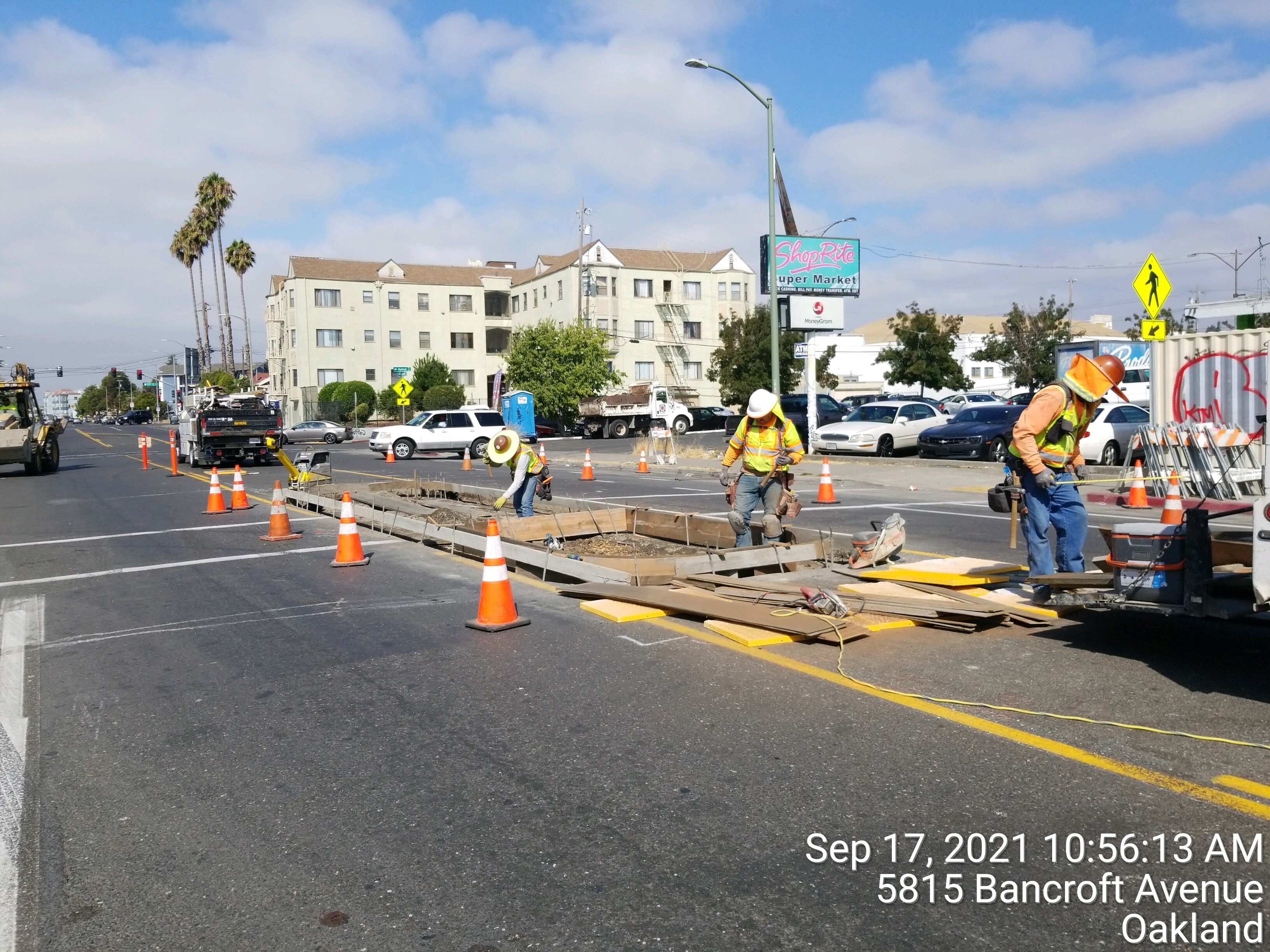The City of Oakland’s Department of Transportation (OakDOT) is developing a network of Slow Streets to promote sustainable travel at human-powered speeds and to encourage the use of these neighborhood streets as community spaces. This effort builds on Oakland’s past work to develop bicycle boulevards (also known as neighborhood bike routes) and lessons learned from neighborhood street closures during the first two years of the Covid-19 pandemic.
What is the Purpose of Slow Streets?
Consider how urban freeways allow people to travel rapidly across the city, and how motor vehicles tend to push other uses off of streets. Pedestrians and bicyclists often feel threatened by the speed and volume of car traffic and people are less likely to know their neighbors on busy streets, let alone socialize or play in the street. Now consider a network of streets designed for slowness, just as freeways are designed for speed. These are streets for walking, biking, and jogging, and for getting about with low-powered electric vehicles. Slow Streets are envisioned as another layer of our transportation system to complement major streets, transit, and freeways. Slow Streets have the potential to provide public spaces and community resources in Oakland’s neighborhoods.
What about the Street Closures during the Pandemic?
During the first two years of the Covid-19 pandemic, OakDOT experimented with Slow Streets, using temporary materials to close 21 miles of streets to through traffic. This pandemic response had many successes, but also significant challenges which ultimately led to its conclusion in early 2022. For the remainder of 2022, OakDOT staff worked through the lessons learned to determine if permanent Slow Streets could be developed in a manner that would keep the successes but avoid the challenges. See this archive for information on pandemic Slow Streets.
What is OakDOT doing to Implement Permanent Slow Streets?
OakDOT staff have developed a framework for implementing permanent Slow Streets that is described in this presentation. It involves both planning considerations (i.e., which streets should be Slow Streets) and design considerations (i.e., what treatments will be installed on those streets). The work is building directly on the planning and design of neighborhood bike routes (i.e., bicycle boulevards) envisioned by Oakland’s 2019 Bicycle Plan. However, there is significant rethinking underway in light of the more inclusive and holistic vision for Slow Streets.
Work is underway to implement improvements through the City’s Five-Year Paving Plan on streets that are also proposed neighborhood bike routes in the City’s 2019 Bicycle Plan. The Bicycle Plan proposes 75 miles of neighborhood bike routes, of which 50 miles are included in the Paving Plan. For these 50 miles of streets, OakDOT staff are identifying locations for new speed humps and traffic circles; how to minimize the number of intersections where cross traffic does not stop; and major intersecting streets that would benefit from crossing improvements.
This approach is shaped primarily by the guidance in OakDOT’s Neighborhood Bike Route Implementation Guide. However, note the changes to signs and pavement markings described in the framework presentation linked above. OakDOT staff intends to update the Neighborhood Bike Route Implementation Guide to be a Slow Streets Implementation Guide. This update will benefit from the experience OakDOT staff is gaining through current work and the public input received on the framework presentation and current Guide.
How can I Provide Input?
OakDOT staff welcomes feedback via email to the contact information listed on this web page. This work is a long-term effort and feedback on the overall approach will be most helpful at this time. Location-specific questions and comments will generally be less helpful as we focus to establish the overall framework. Supporters may be disappointed at the speed at which the work is advancing. In contrast to the pandemic, this rollout is gradual and incremental. People who had concerns with the pandemic street closures may be relieved to know that work is proceeding slowly and incrementally, with a focus on speed humps, traffic circles, and determining the streets that are appropriate to become Slow Streets.
What are Essential Places?
“Essential services” was a key concept in the early period of the Covid-19 pandemic – those services that were essential to people’s well-being and could not be shut down during shelter-in-place. OakDOT staff recognized this concept as a useful prioritization tool for identifying where vulnerable populations are likely to travel to in meeting their basic needs. To formalize this approach, OakDOT staff adopted the term “Essential Places”.
Essential Places include schools, health clinics, early childhood development centers, senior centers, libraries, recreation centers, public transportation, and grocery stores. There are approximately 380 such locations in Oakland. This approach is currently being used in the prioritization of traffic safety service requests. OakDOT staff are seeking additional opportunities to develop Essential Places as a planning and prioritization tool for safety improvements.
Can I Request a Slow Street for my Street?
No. During the pandemic there was significant interest from residents in having their streets be closed to through traffic. Some residents were interested in the traffic calming benefits, whereas other residents were seeking to use their streets for socializing with neighbors. During the pandemic OakDOT did not have the resources to proactively address this interest and this continues to be the case. OakDOT hopes to develop a “Pop-up Slow Streets” program that would support residents in closing their streets for block parties. OakDOT is interested in these events to promote streets as community spaces for social gatherings and games. A Pop-up Slow Streets program would help develop a local culture of using streets as neighborhood resources.
If you are seeking traffic calming for your street, see how to apply for a speed bump. If you would like to hold a block party, you can do so through the special event permit process. If you have suggestions for streets to include in a network of Slow Streets, you can provide input via email to the contact listed on this web page.
Documents
Last updated: 2/21/2023
